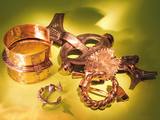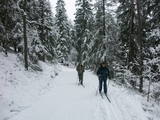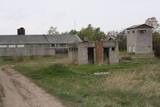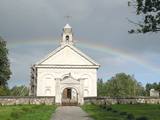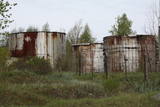| Нo | Название | Описание |
|---|---|---|
|
Лиелстраупский замок - единственная сохранившаяся в Латвии постройка, где в одном здании объединены средневековый замок и церковь. Строительство замка началось в 1263 году. Постройка серьезно пострадала во время XVII и XVIII вв., а также во время революции 1905 года. Комплекс восстановлен в 1909 г. по проекту архитектора В. Бокслафа. В Лиелстраупской церкви находится несколько художественных памятников - хоры органа XVII в. и живопись кафедры XVIII в. В 1944 г. в церкви установлены витражи художника С. Видберга «Голгофа» и «Рождение Христа». На башне замка видны часы, сделанные местным часовщиком Айде, а на стене церкви - солнечные часы. В парке замка следует осмотреть построенную в 1744 году деревянную колокольню. В 1938 году в церкви открыли мемориальную доску, установленную в память о павших во время Первой мировой войны и в боях за свободу. С 1963 г. в замке работает наркологическая больница. Церковь можно осмотреть во время богослужений, а остальной комплекс зданий - извне. |
||
|
This pyramid-shaped hillock with an observation tower at the top of it was established by the Soviet military. It is along the Ķevele-Saldus road, where the Zvārde airfield used to be located. It was used as an observation facility to co-ordinate army training manoeuvres. There is a view of the former airfield and the massive forests of the Zvārde Nature Park and nature reserve. It is an appropriate location for bird-watching. Note that there are no improvements there.
|
||
|
Pankūku kafejnīca. Dažādi oriģināli pildījumi. Kafejnīca piedāvā svaigi grauzdētu kafiju, kafijas un alkoholiskos dzērienus, kā arī uzkodas. Atvērta tipa virtuve. |
||
|
Пиво и рыба – важная часть латышского наследия. Этот тур познакомит вас с Латвией в свете этих двух фундаментальных компонентов. Находясь в Риге, вы отведаете пиво из всех четырех регионов Латвии и типичные закуски – в качестве введения. Затем маршрут ведет в деревню. Сначала будет остановка в Баусской пивоварне, которая гордится своей продукцией без консервантов. Затем визит во Дворец Рундале и на реконструкцию старинного семигальского замка в Тервете. По плану визит в пивоварню Тервете, которая является частью мультифункциональной агрокомпании. Все составные компоненты их пива производятся местными производителями. На следующий день вы увидите, как производится пиво в домашних условиях традиционными способами и почуствуете разницу. А затем маршрут ведет в Лиепаю. В этом городе найдете красивый пляж из белого песка, художественный центр города и внушительное военное наследие в пригороде Караоста, который в настоящее время используется в основном туристами. Затем маршрут идет в маленький живописный городок Кулдигу с ее хорошо сохранившимся деревянным зодчеством и самым широким водопадом в Европе. И еще один визит в пивоварню – на этот раз Ужавскую- которая специализируется на живом пиве. Затем осмотр достопримечательностей в портовом городе Вентспилс и рыбацкий обед и игры в маленьком портовом городке Роя. На следующий день погуляйте утром по пляжу, а затем отправляйтесь с экскурсией в дом рыбака, чтобы понаблюдать за процессом копчения рыбы. А потом маршрут поворачивает обратно к Риге, с прогулкой по таинственному болоту в Национальном парке Кемери и остановкой на морском курорте Юрмала, с ее характерными деревянными виллами 19 века и ланчем в ресторане картофеля. |
||
|
Atrodas Labraga – Apriķu ceļa malā. Kāds nostāsts vēsta, ka to 1896. gadā cēlis vietējais muižkungs, kurš vēlējies, lai viņa meitas laulības notiktu baznīcā. Dievnamā atrodas altārglezna "Kristus pie krusta un Sv. Marija Magdalēna", kas gleznota 19. gadsimtā (autors T. Šprengels). |
||
|
Музей Малтской 2-й средней школы. Галерея украшений
древних латгальцев 6 – 13 веков.
Время работы: 9.00 – 16.00, Сб.,Воскр.: выходные |
||
|
Grūti iedomāties, ka vēl joprojām Eiropā ir apdzīvotas vietas, kuru sasniegšanai ir labu laika sprīdi jābrauc pa neapdzīvotu mežu ieskautu smilšainu ceļu, kur tikai paretam var redzēt kādu sēņotāju vai ogotāju! Tāpat kā Zervinos ciemam, arī šim ir piešķirts kultūras mantojuma pieminekļa statuss, jo Linežeris ir viens no dažiem nacionālā parka etnogrāfiskajiem ciemiem. Linežerī ir aplūkojamas 19. – 20. gs. mijā celtās ēkas un apskatāms tā laika ciema plānojums. Šejieniešu tāpat kā citu dzūku galvenā nodarbošanās bija mežistrāde un meža velšu vākšana. Nelielā mērā – arī lauksaimniecība. Apceļojot nacionālā parka etnogrāfiskos ciemus, rodas pamatots jautājums: „Ar ko mūsdienās te nodarbojas cilvēki. Kā viņi spēj dzīvot tik nomaļā vietā”? Jāatzīst, ka lielākā daļa te ierodas tikai vasaras laikā. Neskatoties uz to, etnogrāfiskie ciemi ir ļoti sakopti un joprojām „dzīvi”! |
||
|
Established: 1959
60 coniferous and 350 deciduous trees
Brief description: Between the Tukums-Kolka road, the Lāčupīte stream and the sea, Igors Mednis has planted a series of foreign trees and shrubs. He has conducted experiments to see how different foreign plants adapt to different conditions. The best time to visit is in May and June, when the rhododendrons are in bloom.
|
||
|
The Neļķes cliffs are in Skaņākalns Park, and they offer the most beautiful view of the Salaka River valley, with its sandstone cliffs and peaceful river. There are good views from the “devil’s pulpit.” It’s worth visiting the Skaņamkalns Hill to check out the views from the famous echo cliff. This is part of the ZBR.
|
||
|
В хозяйстве из ревеня, березового сока и яблок делают домашнее вино. Посетители могут ознакомиться с винодельней и процессом производства. Дегустация и покупка продукции. |
||
|
The capital of Estonia. The Old Town of Tallinn - excellent medieval (14.-15th century) building monument. The former city of Hanza. |
||
|
Baznīca atrodas Sodu ielā (Sodų gatve) 8. Tās pirmsākumi meklējami 1409. g. (viena no vecākajām Lietuvas baznīcām), kad Lietuvas dižkunigaitis Vītauts Dižais izveidoja Traķu apgabala baznīcu. Dievnams joprojām ir pazīstams ar 1123. g. Konstantinopolē gleznotās Traķu Dievmātes gleznu, kuru it kā Vītautam 1390. g. uzdāvinājis Bizantijas ķeizars Emanuels Paleologs II. Šis fakts gan ir jāuzskata par leģendu, ko aprakstījis vēsturnieks Albertas Vijūkas – Kojalavičius, jo 1645 g. gleznas restaurācijas laikā noskaidrojās, ka tā ir tapusi 15 gs. beigās vai 16. gs. sākumā. Traķu Dievmātes glezna ir pirmā Lietuvas pāvesta vainagotā glezna (vainagošanas ceremonija notika 1718 g.), pēc kuras brīnumus piedzīvojuši daudzi ticīgie - gan katoļi, gan pareizticīgie, gan pagāni, gan tatāri. Latvijā - Aglonas bazilikā atrodas šīs gleznas kopija, ko uzskata par svētu! Vislabākais skats uz baznīcu, Traķu ezerpili un Traķiem paveras no klaja paugura Galves (Galvė) ezera ziemeļu krastā. |
||
|
The nature park near the town of Ogre is a popular place for leisure, hiking and, in the winter, cross-country skiing. Most of the park is covered with coniferous trees that are on a long and comparatively narrow line of hillocks with steep sides – another element of nature left behind in Latvia by the Ice Age. Many different plants can be found here. The Jaunogres castle hill is one of the most distinct hillocks in the area. |
||
|
Z / S "Kaņepītes" is a family company founded in 1992. The farm takes its name from the name of the house given to it in 1924. Organic farm where cereals are grown and processed into food. The production of the products is small, but the technique has an ancient atmosphere, a stone, wooden mill that gives a special taste and aroma to flour and oatmeal. Now the assortment already has 30 different product types. |
||
|
Бывшая Плявмальская часть связи в настоящее время используется в качестве склада сельскохозяйственной продукции и принадлежит крестьянскому хозяйству.
|
||
|
Кафе в центре Саулкрасты. Предлагаются не только кондитерские изделия, но и теплые блюда. Среди жителей и гостей города Саулкрасты популярностью пользуются кебабы в латышском вкусе. В кафе имеются стульчики для малышей. Время работы: летом с 8:00 до 20:00, с сентября по май с 8:00 до 18:00. |
||
|
Рикавский (Балтинский) Римско-католический костёл
Божьего Провидения построен в Рикаве в 1829 году на средства
графа Александра Рика и был предназначен попечению
божественного провидения. В костёле имеются: картина Богоматери, „Святой Антоний”, „Явление
Христа Марии Магдалене”. Рядом с церковью находится кладбище и фамильный склеп помещика
Рика.
|
||
|
В Лиепене Вентспилского района находится бывшая военная часть погранохраны, которая в настоящее время является частной собственностью и используется туристами в качестве места проживания.
|
||
|
В настоящее время территория ракетной транспортной части военного порта не используется, относительно огорожена и частично закрыта.
|
||
|
This is one of two sanatoriums in Jūrmala where mud from the surrounding area is used for medical procedures. The Jūrmala Spa Museum of History was opened here in 2009, and it offers interesting information about the history of the spa and the sanatorium. You will see historical photographs and medical equipment from the 1970s and 1980s. Guides will tell you all kinds of interesting information. |
||







